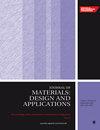Microwave-assisted fabrication of high-strength natural fiber hybrid composites for sustainable applications: An experimental and computational study
IF 2.2
4区 材料科学
Q3 MATERIALS SCIENCE, MULTIDISCIPLINARY
Proceedings of the Institution of Mechanical Engineers, Part L: Journal of Materials: Design and Applications
Pub Date : 2024-08-06
DOI:10.1177/14644207241269567
引用次数: 0
Abstract
The present study deals with the fabrication of hybrid composites using biodegradable and ecologically friendly natural fibers and a recyclable thermoplastic matrix. Pure and hybrid natural fiber composites of high-density polyethylene (HDPE) with Kenaf and Ramie fiber, 20 wt%, were fabricated using microwave-assisted compression molding. The composite's mechanical characterization was performed using tensile, flexural, impact, and hardness tests. X-ray diffraction was done to investigate the crystallinity percentage, and scanning electron microscopy of fractured surfaces was performed to determine failure mechanisms. The hybrid composite of HDPE/Ramie and Kenaf exhibited the highest ultimate tensile strength (UTS) at 29.3 ± 1.2 MPa, surpassing HDPE/Kenaf (21.6 ± 1.1 MPa) and HDPE/Ramie (24.3 ± 1.4 MPa) composites. In terms of flexural strength, HDPE/Ramie demonstrated the highest at 19.9 ± 1.5 MPa, while HDPE/Kenaf had the lowest at 18 ± 1.1 MPa. The hybrid composite's flexural strength was intermediate at 19 ± 1.3 MPa. Impact strength followed a similar trend, with the hybrid composite leading at 40.2 KJ/m用于可持续应用的高强度天然纤维混合复合材料的微波辅助制造:实验与计算研究
本研究涉及使用可生物降解的生态友好型天然纤维和可回收的热塑性基体制造混合复合材料。研究人员利用微波辅助压缩成型技术制造了纯天然纤维和混合天然纤维复合材料,高密度聚乙烯(HDPE)中含有 20 wt% 的 Kenaf 和苎麻纤维。使用拉伸、弯曲、冲击和硬度测试对复合材料进行了力学表征。通过 X 射线衍射研究了结晶度百分比,并对断裂表面进行了扫描电子显微镜观察,以确定失效机理。HDPE/Ramie 和 Kenaf 混合复合材料的极限拉伸强度(UTS)最高,为 29.3 ± 1.2 兆帕,超过了 HDPE/Kenaf(21.6 ± 1.1 兆帕)和 HDPE/Ramie(24.3 ± 1.4 兆帕)复合材料。在抗弯强度方面,高密度聚乙烯/拉米复合材料的抗弯强度最高,为 19.9 ± 1.5 兆帕,而高密度聚乙烯/槿麻的抗弯强度最低,为 18 ± 1.1 兆帕。混合复合材料的抗弯强度介于 19 ± 1.3 兆帕之间。冲击强度也呈类似趋势,混合复合材料的冲击强度最高,为 40.2 KJ/m2,其次是 HDPE/Ramie(26.9 KJ/m2)和 HDPE/Kenaf(12.3 KJ/m2)。硬度测试表明,混合复合材料的硬度最高,而 HDPE/Kenaf 的硬度最低。为了建立预测混合复合材料的模型,还进行了计算研究。结果表明,这两项研究结果非常吻合。所开发的复合材料被认为适用于各种轻型应用,如屋顶、汽车内饰板和手机套,在减少碳足迹方面具有潜在优势。
本文章由计算机程序翻译,如有差异,请以英文原文为准。
求助全文
约1分钟内获得全文
求助全文
来源期刊

CiteScore
4.70
自引率
8.30%
发文量
166
审稿时长
3 months
期刊介绍:
The Journal of Materials: Design and Applications covers the usage and design of materials for application in an engineering context. The materials covered include metals, ceramics, and composites, as well as engineering polymers.
"The Journal of Materials Design and Applications is dedicated to publishing papers of the highest quality, in a timely fashion, covering a variety of important areas in materials technology. The Journal''s publishers have a wealth of publishing expertise and ensure that authors are given exemplary service. Every attention is given to publishing the papers as quickly as possible. The Journal has an excellent international reputation, with a corresponding international Editorial Board from a large number of different materials areas and disciplines advising the Editor." Professor Bill Banks - University of Strathclyde, UK
This journal is a member of the Committee on Publication Ethics (COPE).
 求助内容:
求助内容: 应助结果提醒方式:
应助结果提醒方式:


